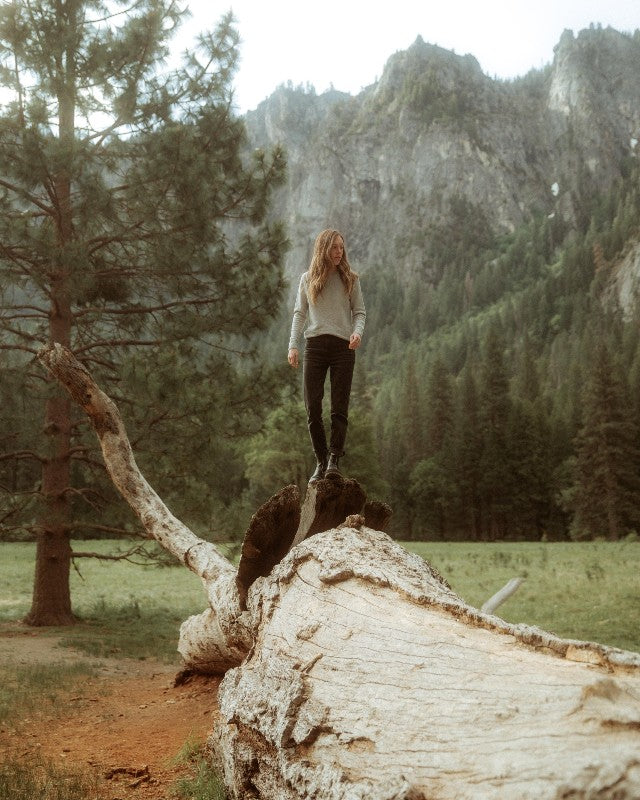Wool Sweaters Can Keep You Alive In The Arid West
East Coast heads west - how two Virginians fell for the high desert and learned the versatility of wool has no bounds.
December 9, 2021
By Lucas Martin
Why Wool Sweaters Are Worn In Deserts
My first desert rat wool sweater was a quarter-zip in green and gray stripes.
After three years of use, my patches needed patching and I traded it in for a wool cardigan, green again, with a Harding Jacquard cross the back.
Wearing wool over the many years has giving me perspective on the quality and purpose of clothing I own and adventure with.
If you are geared toward sustainability, check out Oliver Charles yak wool sweaters - similar quality to cashmere without the guilt that comes from funding industry-induced desertification.
We love deserts, but even we’re unnerved watching their slow
worldwide creep into arable land.

Why Yak Wool Is The Worlds Best Wool
Ultimately, when taking adventures outdoors in the desert for days on end, your sweater’s brand
doesn’t matter so much as its material.
Wools and especially yak wool are a naturally insulating fiber that traps moisture,
heat, and air, creating a humid atmosphere in miniature between skin and garment.
This is useful when the atmosphere outside refuses to hold heat; pulling a light wool sweater
over bare skin and working up a sweat gives you immediate and enduring warmth.
Don’t worry too much
about the sweat seeping into your sweater. Wool’s antimicrobial properties ensure you can work
up some warmth in it the morning after morning without accruing the mighty funk that clings to
cotton and synthetics.

Light Wool Sweaters Are Key To Layering
Because you’ll likely have to carry your own water when traveling in the desert for days
on end, and because water is damn heavy, you’ll want to keep everything else pretty minimal.
Thick jackets are tough against steady wind, but heavier than wool, and don’t pack well in a
rucksack.
Though light and malleable, synthetics rip easily, and their insulation tends to degrade with heavy use.
Plus, most synthetic clothing materials are derived byproducts of oil and natural
gas refinement, and I’d rather support shepherds than refineries.
Wool layers like an Oliver Charles sweater strike the necessary
balance between weight and sturdiness when confronting the desert’s dramatic diurnal
temperature swings.

Times When I've Worn Wool Out Of Need
My wife Ingrid and I struck out for the Oregon Badlands Wilderness within hours of
disembarking the plane from Virginia.
We’d both come-up on the claustrophobically lush East
Coast, learned since childhood to distinguish poison ivy from oak from mere kudzu, learned to
tell one hill from another in the subtle, eroded topography.
After a few years of daydreaming
together, we’d finally made the jump west and landed in Bend, Oregon.

Bend straddles the line where mountains turn to desert.
West is the Cascade Range with
its big - though intermittent - snows, ski resorts, high July
meadows.
Northeast are the Ochocco Mountains which farther northeast become the Blues
which become the Wallowas which merge with the upper neck of the Rockies where Idaho starts
to taper.
Southeast is desert: blown-out unstructured shield volcanoes, alkali flats, and great sandy uplift ranges running regular as waves all the way to Salt Lake City.
This was the direction we were interested in. That first day in Oregon, walking miles under June sun in sand through juniper and sage without breaking a sweat, we fell terribly and immediately in love with the desert.

Day And Night: Life Without Humidity
Even great loves like the desert can turn tumultuous, sometimes even dangerous, if you don’t
keep your wits about you.
It’s easier to fight with people than with landscapes; people just give a
cold shoulder, but landscapes can give a cold night.
Oregon’s desert is technically a high desert above 3500 feet elevation, which means it gets chilly after dark.
Our first full night camping in the high desert was in October near Kimberly, OR and the
Blue Basin unit of the John Day Fossil Beds National Monument.

Fire season had fairly well
concluded in Bend, and we were naïve enough to believe conditions would be similar in
Kimberly. I even brought firewood.
Conditions were not similar in Kimberly. Autumn rains hadn’t stretched this far east yet,
and campfires were still very much prohibited even at our semi-established campground.

It was
maybe fifty-five degrees when we finished our dinner of dry goods, with the sun glowing duskblue behind a nearby butte.
When coyote calls and curious mule deer woke us in the night, the
temp had dropped 30 degrees and our breath was condensing as nubby icicles on the ceiling of
our tent.
We stripped what clothes we still wore and cuddled into one sleeping bag. We cussed wildfires, lusted for warmth, and imagined those deer sniffing our tent something more sinister.

We woke with dawn and laughed at our night terrors while pulling on wool sweaters.
We panted out forty jumping-jacks in crisp morning sun before breakfast.
Without any
humidity to hold the sun’s warmth, the day would keep cold well into our morning hike. We
were grateful to be wearing wool.

Go-To Wool Sweater For Any Climate
Humans have shepherding wool-bearing beasts through semi-arid and arid regions
from prehistory to the present.
However, modern American society most associates wool clothing with
either well-heeled socialites or backwoods mountain folk
confined to snowbound cabins.
This shouldn’t be the case. As more of our nation’s population
shifts toward our arid western states, more folks will find themselves recreating overnight in the
desert and needing a way to keep warm.
Wool is a wardrobe essential, and should be a
part of any desert rat’s rucksack.
Photo Credits:
- Jed Weingarten
- Lucas Martin
Lucas Martin is a freelance journalist based near the Puget Sound. With a background in geographic information systems and wilderness conservation, he writes from the intersection of cartography, ecology, and culture.
If you believe that every good wardrobe starts with owning less and owning better, consider buying yourself an OLIVER CHARLES sweater.
Shop NowSustainable Sweaters For Self-Care
How investing in a sustainable wardrobe benefits our mental health.
Read more7 Day Challenge: Yak Wool Is Perfect For Winter And Spring
Testing the Oliver Charles All Season Boat Neck in classic Wyoming winter activities.
Read moreSeasonal Minimalist Wardrobe Is Out
All you need is one Oliver Charles sweater for all seasons.
Read moreThis Yak Wool Sweater Elevated My Wedding Weekend Wardrobe
How I stayed comfortable and stylish in a sweater during my wedding festivities.
Read more



